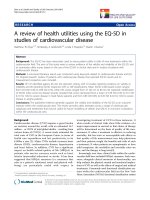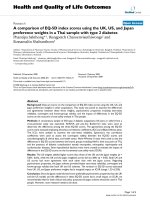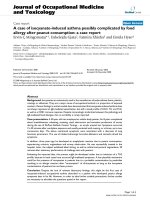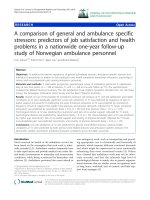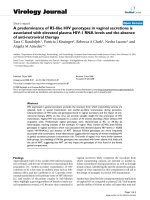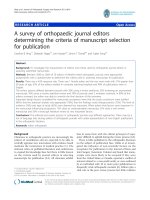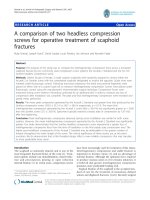Báo cáo hóa học: "A RECONSIDERATION OF HUA’S INEQUALITY. PART II HIROYUKI TAKAGI, TAKESHI MIURA, TAKAHIRO" potx
Bạn đang xem bản rút gọn của tài liệu. Xem và tải ngay bản đầy đủ của tài liệu tại đây (503.19 KB, 8 trang )
A RECONSIDERATION OF HUA’S INEQUALITY. PART II
HIROYUKI TAKAGI, TAKESHI MIURA, TAKAHIRO HAYATA,
AND SIN-EI TAKAHASI
Received 20 April 2006; Accepted 16 May 2006
We give a new interpretation of Hua’s inequality and its generalization. From this inter-
pretation, we know the best possibilit y of those inequalities.
Copyright © 2006 Hiroyuki Takagi et al. This is an open access article distributed under
the Creative Commons Attribution License, which permits unrestricted use, distribution,
and reproduction in any medium, provided the original work is properly cited.
1. Introduction
In 1965, L. Keng Hua discovered the following inequality.
Theorem 1.1 [2]. If δ,λ>0 and x
1
, ,x
n
∈ R, the n
δ −
n
i=1
x
i
2
+ λ
n
i=1
x
i
2
≥
λδ
2
λ + n
. (1.1)
In (1.1), the equality holds if and only if x
1
=··· = x
n
= δ/(λ + n).
This inequality played an important role in number theory and has been generalized
in several directions [1, 3–6]. One of its generalizations states the following.
Theorem 1.2 [5, Corollary 2.7]. Let X be a real or complex normed space with dual X
∗
,
and suppose p,q>1 and 1/p+1/q
= 1.Ifδ, λ>0, x ∈ X,and f ∈ X
∗
, then
δ − f (x)
p
+ λ
p−1
x
p
≥
λ
λ + f
q
p−1
δ
p
. (1.2)
In (1.2), the equality holds if and only if f (x)
=f x and x=δ f
q−1
/(λ + f
q
).
In this paper, we give a new interpretation of the inequality (1.2) and consider whether
the coefficients λ
p−1
and (λ/(λ + f
q
))
p−1
are best p ossible. For this purpose, we divide
Hindawi Publishing Corporation
Journal of Inequalities and Applications
Volume 2006, Article ID 21540, Pages 1–8
DOI 10.1155/JIA/2006/21540
2 A reconsideration of Hua’s inequality. Part II
both sides of (1.2)by(λ/(λ +
f
q
))
p−1
δ
p
, and then replace x/δ by x.Thusweobtaina
replica of Theorem 1.2.
Theorem 1.3. Let X be a real or complex normed space with dual X
∗
,andsupposep,q>1
and 1/p+1/q
= 1.Ifλ>0, x ∈ X,and f ∈ X
∗
, then
λ + f
q
λ
p−1
1 − f (x)
p
+
λ + f
q
p−1
x
p
≥ 1. (1.3)
In (1.3), the equality holds if and only if f (x)
=f x and x=f
q−1
/(λ + f
q
).
Clearly, Theorems 1.2 and 1.3 are equivalent. So, we turn our attention to Theorem 1.3,
which is more convenient for us. Put
Ω
=
1 − f (x)
,x
: x ∈ X
. (1.4)
Then Ω is a subset of
R
+
× R
+
,whereR
+
={s ∈ R : s ≥ 0}. Moreover , we have
Ω
⊂
(s,t) ∈ R
+
× R
+
: s+ f t ≥ 1
, (1.5)
because
|1 − f (x)| + f x≥1 −|f (x)| + f x≥1forallx ∈ X. While the inequal-
ity (1.3)hastheform
as
p
+ bt
p
≥ 1 ∀(s,t) ∈ Ω, (1.6)
where a and b are nonnegative constants. If we know all the nonnegative constants a and
b such that (1.6) holds, then we may determine w hether the coefficients ((λ +
f
q
)/λ)
p−1
and (λ + f
q
)
p−1
in (1.3) are best possible.
2. General theory
Let k and be positive numbers. Let Ω be an index set such that
Ω
⊂
(s,t) ∈ R
+
× R
+
: ks+ t ≥ 1
. (2.1)
For such an index set Ω and any p>0, we consider the domain
D(p; Ω)
=
(a,b) ∈ R
+
× R
+
: as
p
+ bt
p
≥ 1 ∀(s,t) ∈ Ω
. (2.2)
We wish to identify the domain D(p;Ω).
We first consider the case p>1. We define a function h
p,k,
ontheopeninterval(k
p
,∞)
by
h
p,k,
(a) =
p
a
a
q−1
− k
q
p−1
a>k
p
, (2.3)
Hiroyuki Takagi et al. 3
where q is the number satisfying 1/p+1/q
= 1. It is easily seen that the function h
p,k,
is
decreasing a nd strictly convex, and that the graph of b
= h
p,k,
(a) has the asymptotic lines
a
= k
p
and b =
p
.Next,weput
S(k,)
=
(s,t) ∈ R
+
× R
+
: ks+ t = 1
. (2.4)
In other words, S(k, ) is the line segment connecting two points (1/k,0) and (0,1/).
Also, we write
Ω for the closure of Ω in the Euclidean plane R × R.
Theorem 2.1. Let k and be positive numbers and let Ω be an index set such that Ω
⊂
{
(s,t) ∈ R
+
× R
+
: ks + t ≥ 1}.Supposethatp>1 and 1/p+1/q = 1. Then the following
assertions hold.
(i) If a>k
p
, then
as
p
+ h
p,k,
(a)t
p
≥ 1 ∀(s,t) ∈ Ω. (2.5)
In (2.5), the equality holds if and only if (s,t)
= ((k/a)
q−1
,(a
q−1
− k
q
)/a
q−1
) ∈ Ω.
This attaining point (s,t) lies on the line segment S(k,).
(ii) D(p;Ω)
⊃{(a,b) ∈ R
+
× R
+
: a>k
p
, b ≥ h
p,k,
(a)}.
(iii) If S(k, )
⊂ Ω, the n
D(p; Ω)
=
(a,b) ∈ R
+
× R
+
: a>k
p
, b ≥ h
p,k,
(a)
. (2.6)
The formula (2.6) says that when a>k
p
and b = h
p,k,
(a), the pair (a,b)isoneofthe
best possible constants such that (1.6)holds.
Before proving Theorem 2.1,wemakesomeremarksonthedomainswhichappearin
(ii) and (iii). Evidently, the domain D(p;Ω)hasthepropertythat
(α,β)
∈ D(p;Ω), a ≥ α, b ≥ β =⇒ (a,b) ∈ D(p;Ω). (2.7)
Next, for each (s,t)
∈ S(k, ), we put
L(p;s,t)
=
(a,b) ∈ R × R : as
p
+ bt
p
= 1
,
Δ(p;s,t)
=
(a,b) ∈ R × R : as
p
+ bt
p
≥ 1
.
(2.8)
In the ab-plane, L(p;s,t) denotes a straight line, and Δ(p;s,t) denotes the closed upper
half plane whose boundary is the line L(p; s,t), while the domain
{(a,b) ∈ R
+
× R
+
: a>
k
p
, b ≥ h
p,k,
(a)} consists of the points above or on the curve b = h
p,k,
(a)(a>k
p
). These
domains have a relation in the following sense.
Lemma 2.2. For positive numbers k and , the following assertions hold.
(i) If ᏸ is a family of the lines
{L(p;s,t):(s,t) ∈ S(k,)}, then the envelope of ᏸ is given
by b
= h
p,k,
(a)(a>k
p
).
(ii)
{(a,b) ∈ R
+
× R
+
: a>k
p
, b ≥ h
p,k,
(a)}=
(s,t)∈S(k,)
Δ(p;s,t).
4 A reconsideration of Hua’s inequality. Part II
Proof. (i) Since S(k,)
={(s,(1− ks)/):0≤ s ≤ 1/k}, the family of lines ᏸ is represented
by
s
p
a +
1 − ks
p
b = 1
0 ≤ s ≤
1
k
. (2.9)
We here remar k that each line of ᏸ has no singular point. Now, put
F(a,b,s)
= s
p
a +
(1
− ks)
p
p
b − 1. (2.10)
Then
∂F
∂s
(a,b,s)
= ps
p−1
a −
pk(1 − ks)
p−1
p
b. (2.11)
Consider the simultaneous equations F(a,b,s)
= 0and(∂F/∂s)(a,b, s) = 0. If 0 <s<1/k,
then the equation (∂F/∂s)(a,b,s)
= 0yields
b
=
p
s
p−1
k(1 − ks)
p−1
a, (2.12)
and so the equation F(a,b, s)
= 0becomes
s
p
a + s
p−1
1 − ks
k
a
− 1 = 0, (2.13)
or, equivalently, a
= k/s
p−1
, w hich implies b =
p
/(1 − ks)
p−1
. Let us delete the letter s in
the resulting equations
a
=
k
s
p−1
, b =
p
(1 − ks)
p−1
0 <s<
1
k
. (2.14)
Since the former equation yields s
= (k/a)
q−1
, the latter equation becomes
b
=
p
1 − k(k/a)
q−1
p−1
=
p
a
a
q−1
− k
q
p−1
= h
p,k,
(a). (2.15)
Also, 0 <s<1/k if and only if a
= k/s
p−1
>k
p
.Thustheenvelopeofᏸ is given by b =
h
p,k,
(a)(a>k
p
).
(ii) Visualize t he domains
{(a,b) ∈ R
+
× R
+
: a>k
p
, b ≥ h
p,k,
(a)} and Δ(p; s, t)for
(s,t)
∈ S(k, ), in the ab-plane. Next, note that the first domain is strictly convex set. Then
we can see (ii) directly from (i).
We are now in a position to prove Theorem 2.1.
Proof of Theorem 2.1. (i) Suppose α>k
p
and β = h
p,k,
(α). To see (2.5), we show that
αs
p
+ βt
p
≥ 1forall(s,t) ∈ Ω.Choose(s,t) ∈ Ω arbitrarily. Then we have ks+ t ≥ 1. So,
we can easily find the point (σ, τ)inS(k,)suchthatσ
≤ s and τ ≤ t.ByLemma 2.2(ii),
Hiroyuki Takagi et al. 5
we have
(α,β)
∈
(a,b) ∈ R
+
× R
+
: a>k
p
, b ≥ h
p,k,
(a)
=
(s,t)∈S(k,)
Δ(p;s,t) ⊂ Δ(p; σ,τ).
(2.16)
Hence ασ
p
+ βτ
p
≥ 1. Thus we have
αs
p
+ βt
p
≥ ασ
p
+ βτ
p
≥ 1, (2.17)
which was to be proved for (2.5).
Let us check the equality condition of (2.5). Suppose that αs
p
+ βt
p
= 1forsome
(s,t)
∈ Ω. Then two inequalities in (2.17) become the equalities. Hence (s,t) = (σ,τ) ∈
S(k,)andασ
p
+ βτ
p
= 1. The last equation means that the point (α,β) lies on the straight
line
σ
p
a + τ
p
b = 1, (2.18)
whichisamemberL(p;σ,τ)ofᏸ. Also, the point (α,β) lies on the graph of b
= h
p,k,
(a)
(a>k
p
), because α>k
p
and β = h
p,k,
(α). H ere we recall from Lemma 2.2(i) that the
curve b
= h
p,k,
(a)(a>k
p
)istheenvelopeofᏸ. These facts and the strict convexity of
h
p,k,
imply that the line (2.18) is tangent to the graph of b = h
p,k,
(a)(a>k
p
) at the point
(α,β). Let us find this tangent line. Since a routine computation shows that h
p,k,
(a) =
−
k
q
p
/(a
q−1
− k
q
)
p
, the desired tangent line is formulated as
b
−
p
α
α
q−1
− k
q
p−1
=−
k
q
p
α
q−1
− k
q
p
(a − α), (2.19)
that is,
k
α
q
a +
α
q−1
− k
q
p
p
α
q
b = 1. (2.20)
Since this denotes the line (2.18), we have
σ
p
=
k
α
q
, τ
p
=
α
q−1
− k
q
p
p
α
q
, (2.21)
and so σ
= (k/α)
q−1
, τ = (α
q−1
− k
q
)/α
q−1
.Thusweobtain(s,t) = (σ,τ) ∈ S(k, )and
(s,t)
= ((k/α)
q−1
,(α
q−1
− k
q
)/α
q−1
).
Conversely, if (s,t)
= ((k/a)
q−1
,(a
q−1
− k
q
)/a
q−1
), then
as
p
+ h
p,k,
(a)t
p
= a
k
a
q
+
p
a
a
q−1
− k
q
p−1
·
a
q−1
− k
q
p
p
a
q
=
k
q
a
q−1
+
a
q−1
− k
q
a
q−1
= 1,
(2.22)
which is the equality in (2.5).
6 A reconsideration of Hua’s inequality. Part II
(ii) By (i), we see that if α>k
p
and β = h
p,k,
(α), then (α,β) ∈ D(p,Ω). Hence (ii)
follows immediately from the property (2.7).
(iii) By (ii), it suffices to show that D(p;Ω)
⊂{(a,b) ∈ R
+
× R
+
: a>k
p
, b ≥ h
p,k,
(a)}.
Pick (α,β)
∈ D(p;Ω). For each (s,t) ∈ S(k, ), there exists a sequence {(s
n
,t
n
)} in Ω such
that s
n
→ s and t
n
→ t, because S(k,) ⊂ Ω. Noting that (α,β) ∈ D(p;Ω)and(s
n
,t
n
) ∈ Ω,
we have αs
n
p
+ βt
n
p
≥ 1. Letting n →∞,weobtainαs
p
+ βt
p
≥ 1. Hence (α,β) ∈ Δ(p;s,t).
Since this holds for all (s,t)
∈ S(k,), it follows that (α,β) ∈
(s,t)∈S(k,)
Δ(p;s,t). Hence
Lemma 2.2(ii) shows that (α,β)
∈{(a,b) ∈ R
+
× R
+
: a>k
p
, b ≥ h
p,k,
(a)}. Thus (iii) is
proved.
Next,weconsiderthecase0<p≤ 1.
Theorem 2.3. Let k and be positive numbers and let Ω be an index set such that Ω
⊂
{
(s,t) ∈ R
+
× R
+
: ks+ t ≥ 1}.Supposethat0 <p≤ 1. Then the following assertions hold.
(i) The inequality k
p
s
p
+
p
t
p
≥ 1 holds for all (s,t) ∈ Ω.If0 <p<1,thentheequality
holds if and only if (s,t)
= (1/k,0) or (0,1/).
(ii) D(p;Ω)
⊃{(a,b) ∈ R
+
× R
+
: a ≥ k
p
, b ≥
p
}.
(iii) If (1/k,0) and (0,1/) belong to
Ω, then D(p;Ω) ={(a,b) ∈ R
+
× R
+
: a ≥ k
p
, b ≥
p
}.
Proof. (i) Since the case p
= 1istrivial,weassumethat0<p<1. For any (s,t) ∈ Ω,
we have ks,t
≥ 0andks + t ≥ 1. By Minkowski’s inequality, we obtain k
p
s
p
+
p
t
p
≥ 1.
Also, an easy consideration implies that the equality holds precisely when (ks,t)
= (1,0)
or (0,1), namely (s,t)
= (1/k,0) or (0,1/).
(ii) The inequality in (i) implies (k
p
,
p
) ∈ D(p;Ω). Hence (ii) follows from (2.7).
(iii) By (ii), it suffices to show that D(p;Ω)
⊂{(a,b) ∈ R
+
× R
+
: a ≥ k
p
, b ≥
p
}.Pick
(α,β)
∈ D(p;Ω). We must show that α ≥ k
p
and β ≥
p
. Since (1/k,0) ∈ Ω, we can find
the sequence
{(s
n
,t
n
)} in Ω such that s
n
→ 1/k and t
n
→ 0. Noting that (α,β) ∈ D(p;Ω)
and (s
n
,t
n
) ∈ Ω,weseethatαs
n
p
+ βt
n
p
≥ 1. Letting n →∞,wehaveα/k
p
≥ 1, namely
α
≥ k
p
. Similarly, we obtain β ≥
p
. Thus we proved (iii).
We close the general theory with the opposite inequalities obtained similarly.
Theorem 2.4. Let k and be positive numbers and let Ω
be an index se t such that Ω
⊂
{
(s,t) ∈ R
+
× R
+
: ks+ t ≤ 1}.Supposethat0 <p<1 and 1/p+1/q = 1.Put
D
(p;Ω
) =
(a,b) ∈ R
+
× R
+
: as
p
+ bt
p
≤ 1 ∀(s,t) ∈ Ω
. (2.23)
Define h
p,k,
(a) =
p
(1 − k
q
a
1−q
)
1−p
for 0 ≤ a<k
p
. Then the following assertions hold.
(i) If 0
≤ a<k
p
, then as
p
+ h
p,k,
(a)t
p
≤ 1 for all (s,t) ∈ Ω
. Here, the equality holds if
and only if (s,t)
= ((a/k)
1−q
,(1− k
q
a
1−q
)/) ∈ Ω
. This attaining point (s,t) lies on
thelinesegmentS(k,).
(ii) D
(p;Ω
) ⊃{(a,b) ∈ R
+
× R
+
: a<k
p
, b ≤ h
p,k,
(a)}.
(iii) If S(k, )
⊂ Ω
, then D
(p;Ω
) ={(a,b) ∈ R
+
× R
+
: a<k
p
, b ≤ h
p,k,
(a)}.
Hiroyuki Takagi et al. 7
Theorem 2.5. Let k and be positive numbers and let Ω
be an index se t such that Ω
⊂
{
(s,t) ∈ R
+
× R
+
: ks+ t ≤ 1}.Supposethatp ≥ 1. Define the domain D
(p;Ω
) by (2.23).
Then the follow ing assertions hold.
(i) The inequality k
p
s
p
+
p
t
p
≤ 1 holds for all (s,t) ∈ Ω
.Ifp>1, then the equality
holds if and only if (s,t)
= (1/k,0) or (0,1/).
(ii) D
(p;Ω
) ⊃{(a,b) ∈ R
+
× R
+
: a ≤ k
p
, b ≤
p
}.
(iii) If (1/k,0) and (0,1/) belong to
Ω
, then D
(p;Ω
) ={(a,b) ∈ R
+
× R
+
: a ≤ k
p
,
b
≤
p
}.
3. The best possibility of Hua type inequality
We now return to Theorem 1.3.WegiveanewproofofTheorem 1.3 by using Theorem
2.1.
Proof of Theorem 1.3. If f is a zero functional on X, then the statements of Theorem 1.3
are trivial. So, we assume that f is nonzero. Set k
= 1and =f .Thenk, >0. Put
Ω
={(|1 − f (x)|,x):x ∈ X}.AswesawinSection 1,wehaveΩ ⊂{(s, t) ∈ R
+
× R
+
:
ks+ t
≥ 1}.Sincep>1, it follows from Theorem 2.1(i) that if a>k
p
= 1, then
as
p
+ h
p,k,
(a)t
p
≥ 1 ∀(s,t) ∈ Ω. (3.1)
In (3.1), the equality holds if and only if s
= (1/a)
q−1
and t = (a
q−1
− 1)/ f a
q−1
.
Note that ((λ +
f
q
)/λ)
p−1
> 1. We now take a = ((λ + f
q
)/λ)
p−1
.Then
h
p,k,
(a) =
f
p
λ + f
q
/λ
p−1
λ + f
q
/λ
−
1
p−1
=
λ + f
q
p−1
. (3.2)
Hence, in this case, (3.1)becomes(1.3). Also, the equality condition is
1 − f (x)
=
λ
λ + f
q
, x=
λ + f
q
/λ
−
1
f
λ + f
q
/λ
=
f
q−1
λ + f
q
. (3.3)
Here the latter equation yields
1 − f (x)
≥
1 −
f (x)
≥
1 −f x=1 −
f
q
λ + f
q
=
λ
λ + f
q
(3.4)
and so the former equation says that the two inequalities above are the equalities. This im-
plies that 0
≤ f (x) ≤ 1and| f (x)|=f x.Hence f (x) =f x. Thus if the equality
holds in (1.3), then f (x)
=f x and x=f
q−1
/(λ + f
q
). The converse is easily
checked by a simple computation.
Next, we show that
S(k,)
⊂ Ω in the above setting. (3.5)
Pick (σ,τ)
∈ S(k,) arbitrarily. Then kσ + τ = 1, namely, σ + f τ = 1. Noting that
f =sup{| f (e)| : e ∈ X, e=1}, we can find a sequence {e
n
} in X such that e
n
=1,
8 A reconsideration of Hua’s inequality. Part II
f (e
n
) ≥ 0and f (e
n
) →f .Putx
n
= τe
n
for n = 1, 2, , and consider the sequence
{(|1 − f (x
n
)|,x
n
)} in Ω.Thenwehave
1 − f
x
n
−
σ
≤
1 − f
x
n
−
σ
=
1 − τf
e
n
−
1 −f τ
=
τ
f
e
n
−
f
−→ 0
(3.6)
as n
→∞.Also,x
n
=τe
n
=τ.Hence(|1 − f (x
n
)|,x
n
) → (σ,τ). Thus we conclude
that (σ,τ)
∈ Ω,and(3.5)wasproved.
Once we have established (3.5), we can apply Theorem 2.1(iii) in the setting of
Theorem 1.3. Thus we conclude that the pair of coefficients
λ + f
q
λ
p−1
,
λ + f
q
p−1
(3.7)
is one of the best pairs of nonnegative constants (a,b)suchthata
|1 − f (x)|
p
+ bx
p
≥ 1
for all x
∈ X. In this sense, we can say that the inequality (1.3) is best possible. Moreover,
we know the best possibility of the inequalities (1.1)and(1.2), because Theorem 1.2 is
equivalent to Theorem 1.1 and Theorem 1.3 is a special case of Theorem 1.2.
References
[1] S. S. Dragomir and G S. Yang, On Hua’s inequality in real inner product spaces, Tamkang Journal
of Mathematics 27 (1996), no. 3, 227–232.
[2] L.K.Hua,Additive Theory of Prime Numbers, Translations of Mathematical Monographs, Vol.
13, American Mathematical Society, Rhode Island, 1965, translated by N. B. Ng.
[3] C.E.M.PearceandJ.E.Pe
ˇ
cari
´
c, A remark on the Lo-Keng Hua inequality, Journal of Mathemat-
ical Analysis and Applications 188 (1994), no. 2, 700–702.
[4] J. Pe
ˇ
cari
´
c, On Hua’s inequality in real inner product spaces, Tamkang Journal of Mathematics 33
(2002), no. 3, 265–268.
[5] H. Takagi, T. Miura, T. Kanzo, and S E. Takahasi, A reconsideration of Hua’s inequality,Journal
of Inequalities and Applications 2005 (2005), no. 1, 15–23.
[6] C L. Wang, Lo-Keng Hua inequality and dynamic programming, Journal of Mathematical Anal-
ysis and Applications 166 (1992), no. 2, 345–350.
Hiroyuki Takagi: Department of Mathematical Sciences, Faculty of Science, Shinshu University,
Matsumoto 390-8621, Japan
E-mail address:
Takeshi Miura: Department of Basic Technology, Applied Mathematics and Physics,
Yamagata University, Yonezawa 992-8510, Japan
E-mail address:
Takahiro Hayata: Department of Informatics, Faculty of Engineering, Yamagata University,
Yonezawa 992-8510, Japan
E-mail address:
Sin-Ei Takahasi: Department of Basic Technology, Applied Mathematics and Physics,
Yamagata University, Yonezawa 992-8510, Japan
E-mail address:



